I did a search for a variable speed electric DA and found several. One's on the way!Mark:
FWIW, the Electric D/A I use for doing sanding and compounding is a Porter Cable 7424XP Model - variable speed and I use a 5 inch pad that has hook and loop on it so I can easily change my paper and pads. For pads, I love the Lake Country "Smart Pads", they come in various levels of aggressiveness. For my buffer, I use a Makita 9227 variable speed, with a 7 inch hook and loop plate and use the Smart Pads and the same hook and loop type buffer (wool like) pads for that as well. My go to place for all things related to sand/compound/buff is www.autogeek.net
The great thing about the PC 7424Xp is that it is small and light enough that it can be handled with one hand, not like the big heavy tourqy buffers. And the Makita is powerful but not near as heavy as my old Craftsman buffer/grinder.
Smart Pads Professional Foam Pads
Smart Pads Professional Foam Pads - Smart Pads Professional Foam Pads were created through a partnership between Palm Beach Motoring Accessories and Lake Country. As many detailers know, Lake Country is the maker of the industrys finest foam pads ...www.autogeek.net
Also, I use their "pad cleaner" powder. And the "Pinnacle" liquid pad Cleaner and pad conditioner. The powder you mix in a 5 gal bucket and as your pads and bonnets get clogged up you just toss the dirty one in the bucket and put on a clean one, 15 minutes in the soup and I use their pad cleaning brush to clean the pad/bonnet, a quick rinse and a spin dry on the Makita and set them in the sun to dry. Generally by the time I clog up the next one the first ones I used are clean and dry. So rinse and repeat. The Pinnacle pad cleaner is like magic, a few sprays on the pad and all the dirty wax/compound just dissolves.
Repairing Hunter 40 damage from Hurricane Matthew
- Thread starter B757Captain
- Start date
The keel joint/barrier coat/bottom paint lalapalooza fiesta extravaganza marathon soiree finale:
After getting some primer on the keel and cleaning up I took a day off - partly because I needed it (!) and partly because I had to go shopping for supplies. With the painting accessories replenished I could get to business:

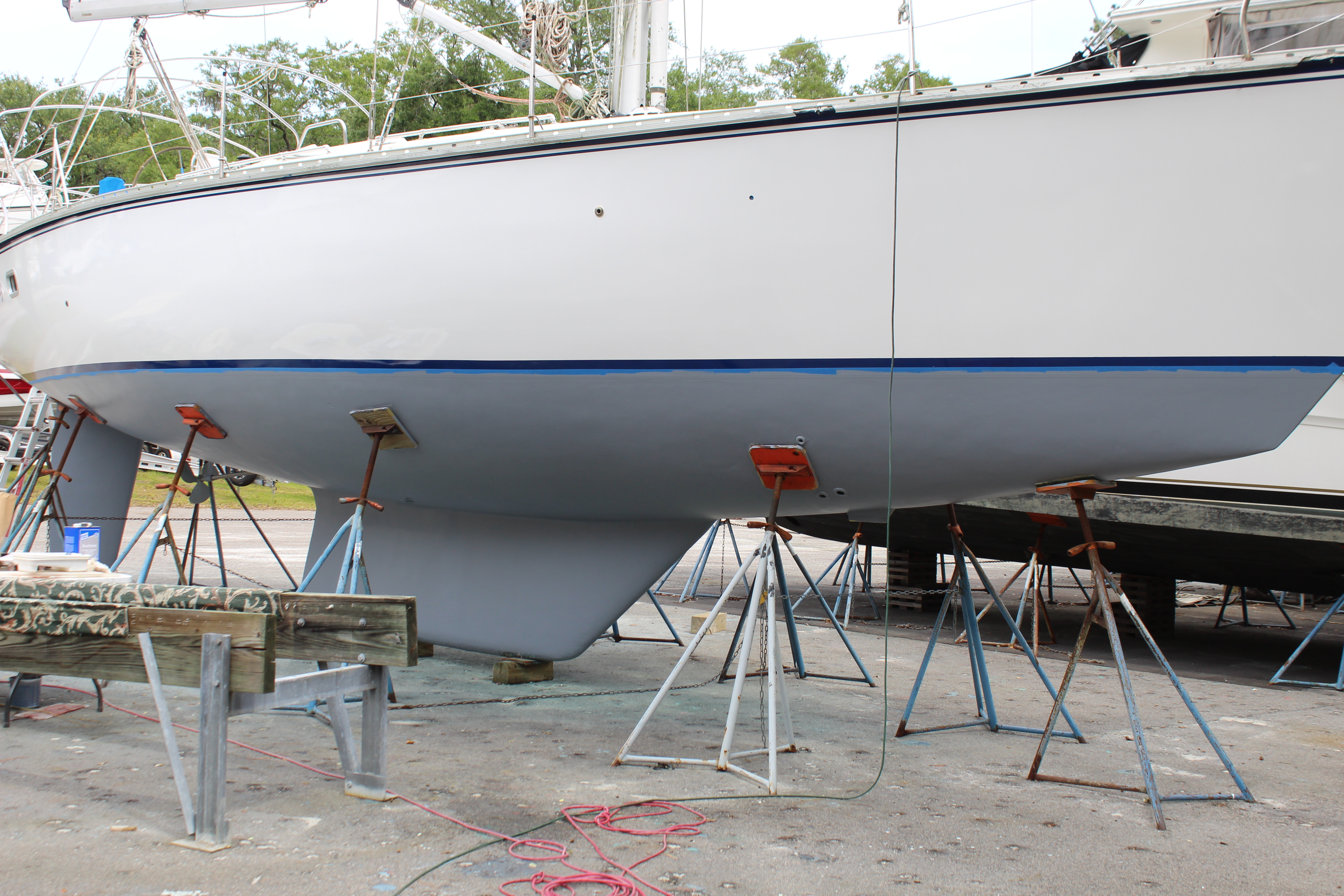
No drama to report, after washing the hull and taping the boot stripe it was just doing laps around the boat with the roller. Long day though and I had to hold off on the last coat (according to the instructions the final barrier coat layer should be fresh for a good chemical bond with the bottom paint).
Next day, final coat of primer and two coats of bottom paint:
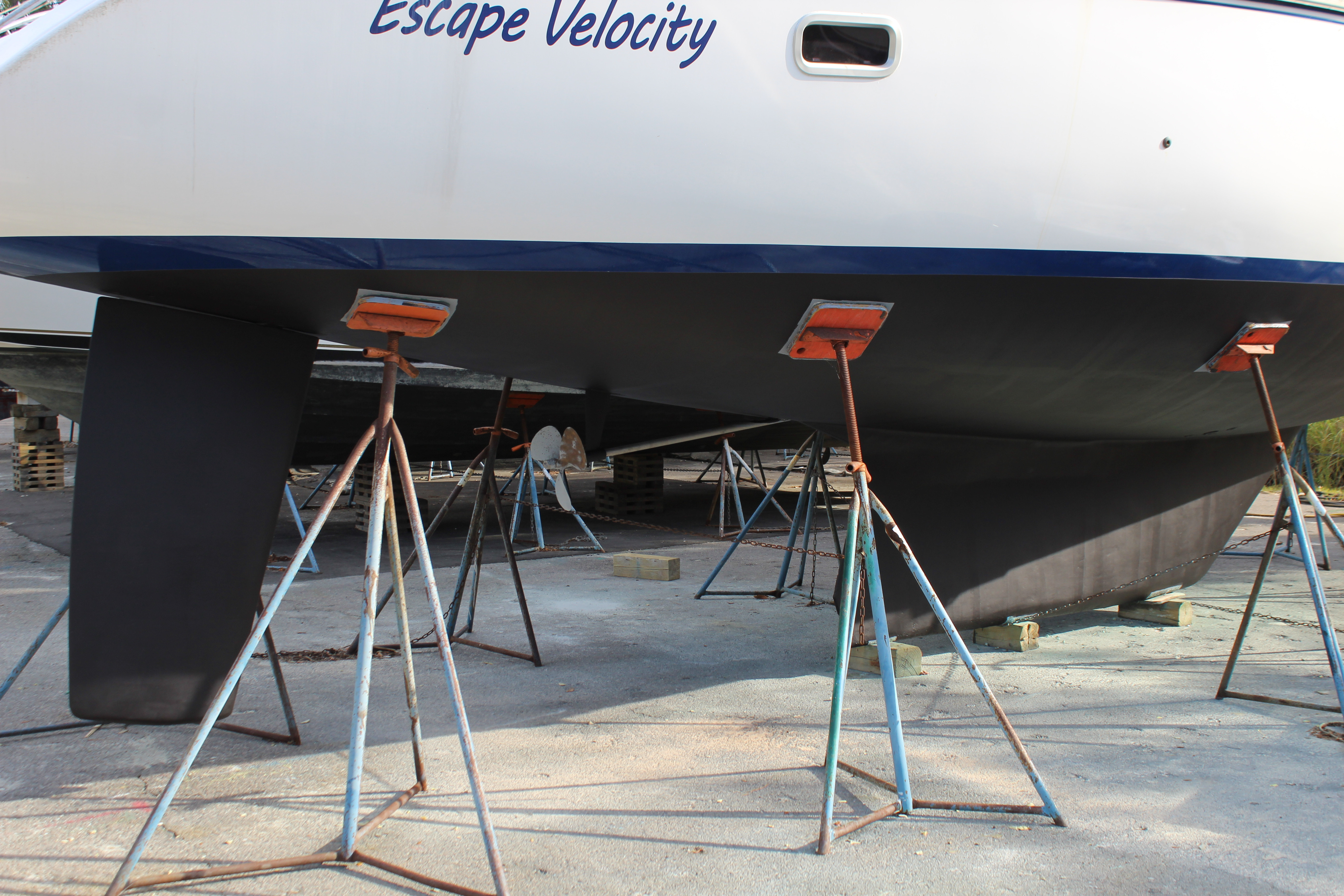

Now for a few days off to recover and let the paint cure and harden, then I'll shift the stands and get the remaining spots.
I gotta say I'm happy with the results - it no longer looks like a repair project!
Cheers,
Mark
After getting some primer on the keel and cleaning up I took a day off - partly because I needed it (!) and partly because I had to go shopping for supplies. With the painting accessories replenished I could get to business:


No drama to report, after washing the hull and taping the boot stripe it was just doing laps around the boat with the roller. Long day though and I had to hold off on the last coat (according to the instructions the final barrier coat layer should be fresh for a good chemical bond with the bottom paint).
Next day, final coat of primer and two coats of bottom paint:


Now for a few days off to recover and let the paint cure and harden, then I'll shift the stands and get the remaining spots.
I gotta say I'm happy with the results - it no longer looks like a repair project!
Cheers,
Mark
No, no it doesn't!
Now for a few days off to recover and let the paint cure and harden, then I'll shift the stands and get the remaining spots.
I gotta say I'm happy with the results - it no longer looks like a repair project!
Cheers,
Mark
Looks great! I am curious how you will paint the bottom of the keel where it is sitting on the blocks. In our local yard, they use a hydrolic trailer and will not lift the boat until it is ready to splash so you only have about 15 minutes to slap on some bottom paint before it goes into the water still wet. 


No, no it doesn't!
Thanks fellas!WOW! Just....wow.
We have a travellift here so when the time comes it can sit in the slings for the time I need to finish the bottom of the keel. I also don't like running the engine above idle speed while on the stands so at the same time it's in the slings I'll do some more substantial engine runs. With proper timing I should be able to get a day or two sitting in the travelliftLooks great! I am curious how you will paint the bottom of the keel where it is sitting on the blocks. In our local yard, they use a hydrolic trailer and will not lift the boat until it is ready to splash so you only have about 15 minutes to slap on some bottom paint before it goes into the water still wet.
Bottom finished:
Ok, after taking a few days off to heal (and let the bottom paint cure) I shifted the stands:
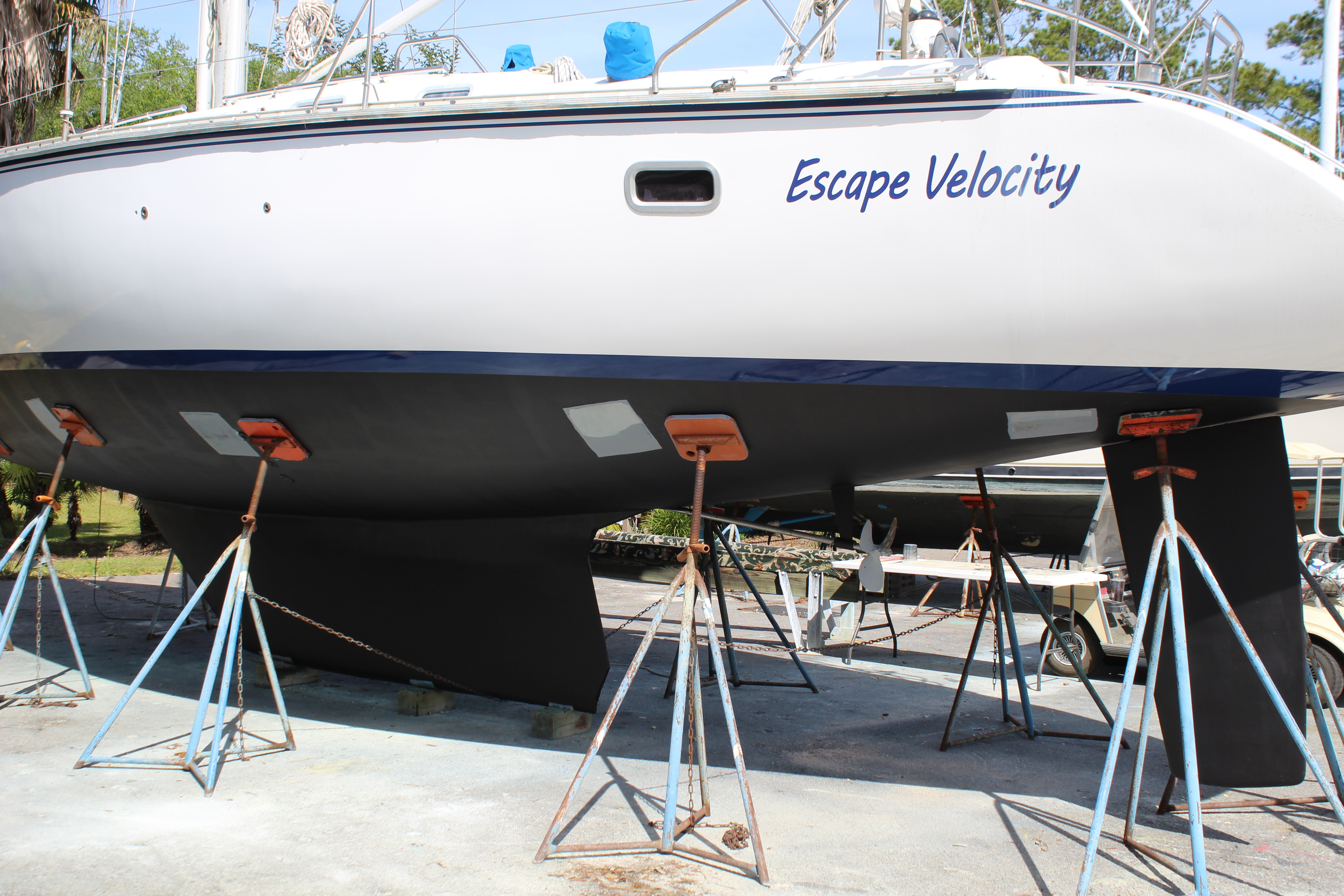
and got three more coats of primer on (I already had several coats from back when we moved to the new spot in the yard) and bottom paint to complete things. Here she sits:
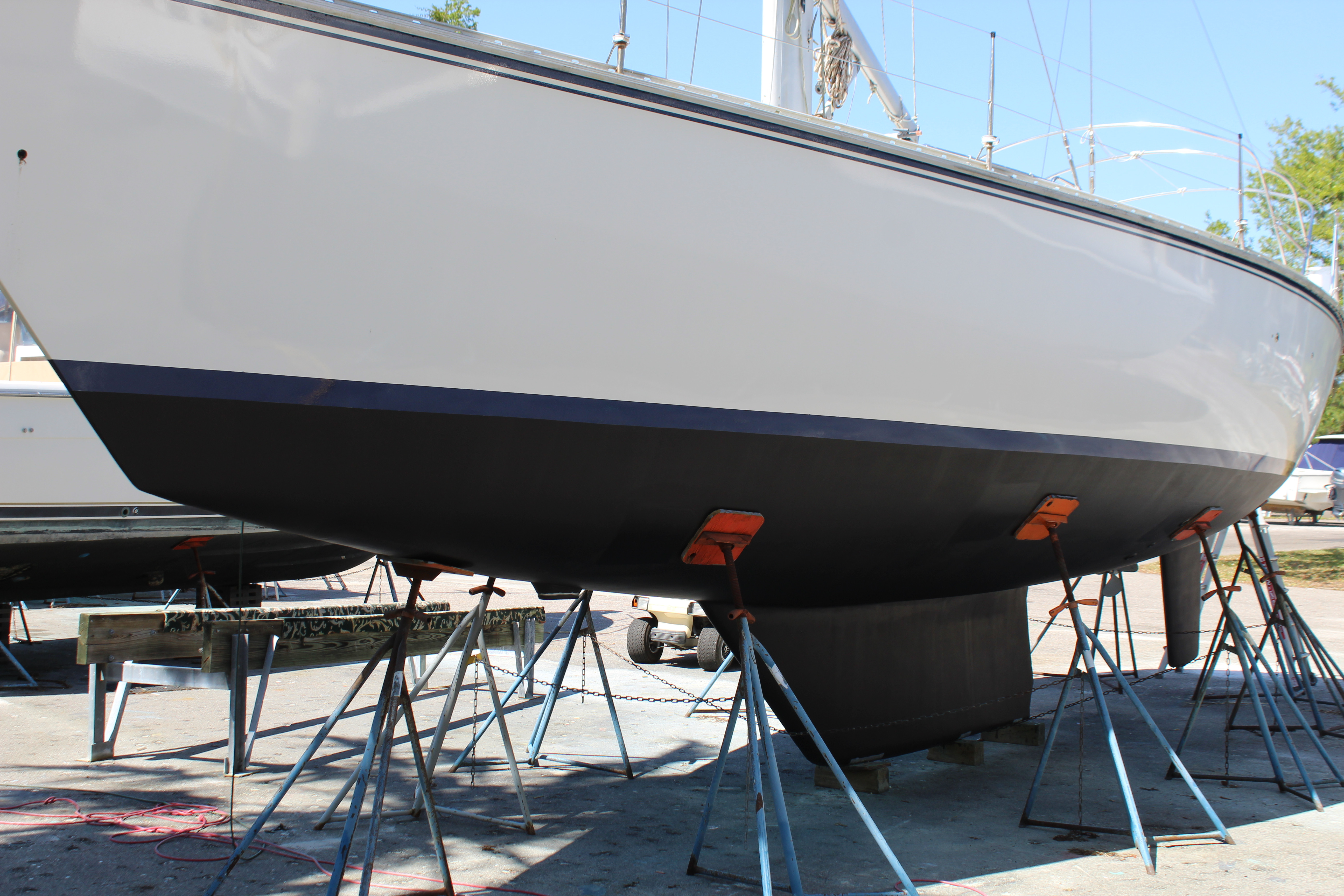
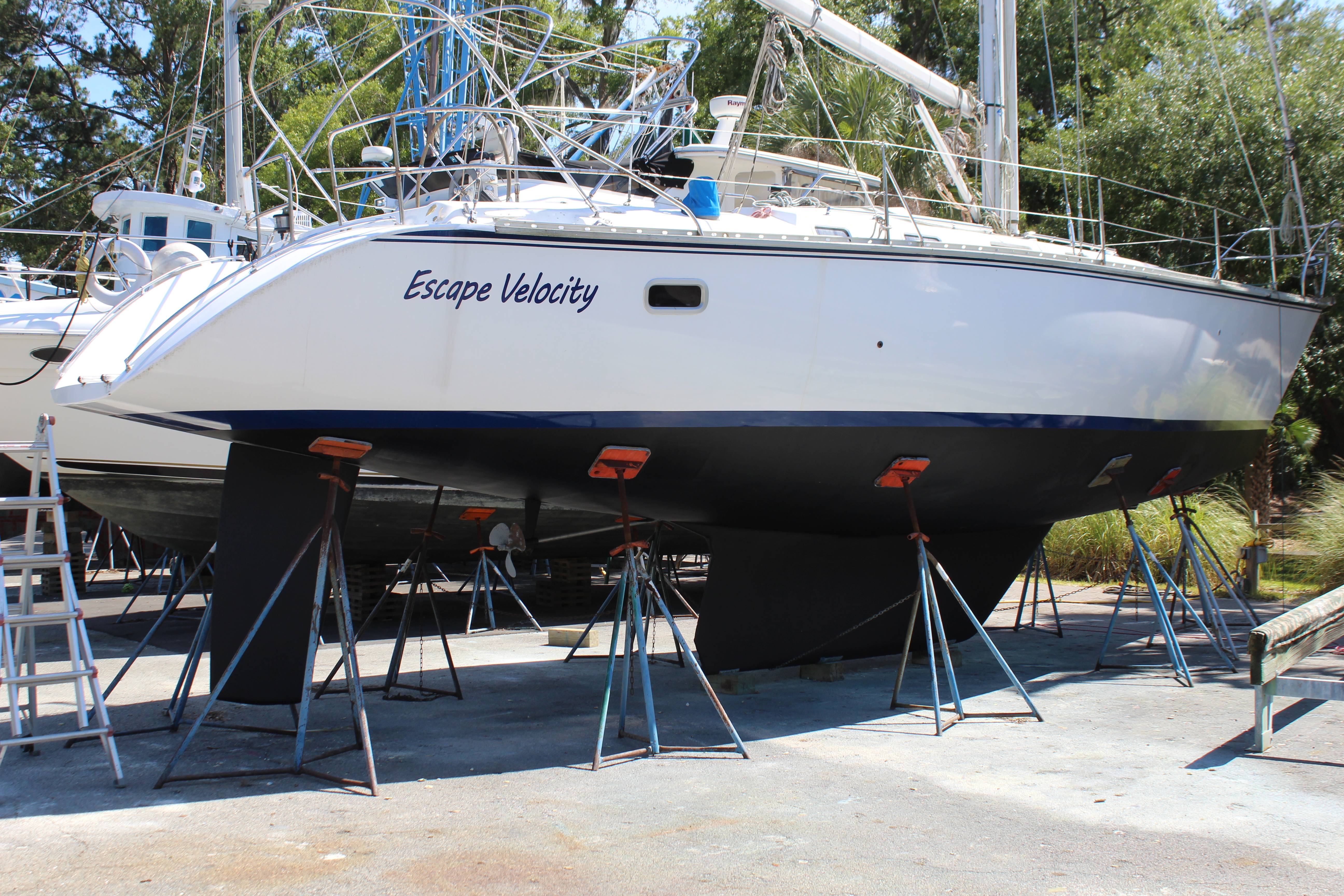
I will be taking several days off to get my bod back to Planet Earth, then on to the next project - hint: a big roll of 1708 should be sitting at the marina now waiting for me, and I tested the foam core panels I bought for compatibility with laminating resin vs. epoxy resin. Epoxy won - the polyester partially melted the foam!
Cheers,
Mark
Ok, after taking a few days off to heal (and let the bottom paint cure) I shifted the stands:

and got three more coats of primer on (I already had several coats from back when we moved to the new spot in the yard) and bottom paint to complete things. Here she sits:


I will be taking several days off to get my bod back to Planet Earth, then on to the next project - hint: a big roll of 1708 should be sitting at the marina now waiting for me, and I tested the foam core panels I bought for compatibility with laminating resin vs. epoxy resin. Epoxy won - the polyester partially melted the foam!
Cheers,
Mark
When I bought my 49, it had one of the last lead keels that Hunter was fitting. They got tired of competing with the other builders who had been using cast iron for years. It’s really hard to sell a customer something that’s below the water.Yep, steel keel. The majority of the keel is in good shape except for the areas around the keel/hull joint where there was water intrusion. In addition I had a few spots of rust where the keel had rough spots from the casting that had improper fairing (looked factory except for a few spots where the repair was done wrong too!). I did multiple treatments with OSPHO and several grinding sessions to remove and neutralize the rust and the barrier coat will be the protection. Time will tell.
When I saw the 49s with the cast iron keel, I was hugely appreciative of the lead keel on mine. The wetted surface is significantly less, and has a huge impact on boat speed, especially in lighter airs. Certainly, the larger the boat, the heavier the keel. Therefore, on the 49 the premium that Hunter was paying for a lead keel was significant
Already agreed that he'll take my boat and give it the old "B757" once over 
I so look forward to your posts. What are we going to do when you finish and launch!!??
I have always been surprised by the iron keels on Hunters and Bene's. As far as I am aware, the only iron keels on a Catalina are the swing keels on the C22 and C25.
The lead vs. steel debate is a tough one. From a metallurgical standpoint, lead comes in at about 700 lbs. per cubic ft where steel (cast iron about the same, small variances depending on alloy) averages 500 lb/(c)ft. - about 70% of the density of lead so logically a steel keel will be 30% larger than lead. Lots of variations here too, though, when wings, bulbs and other gizmos are added into the mix. Steel (or cast iron) rusts, lead doesn't (it oxidizes, yes, but doesn't corrode like steel or iron). Lead is much softer though, and as in the case of my boat, the steel keel allows for a much stronger attachment to the boat. Is that really necessary? I would say not until the day it is!When I bought my 49, it had one of the last lead keels that Hunter was fitting. They got tired of competing with the other builders who had been using cast iron for years. It’s really hard to sell a customer something that’s below the water.
When I saw the 49s with the cast iron keel, I was hugely appreciative of the lead keel on mine. The wetted surface is significantly less, and has a huge impact on boat speed, especially in lighter airs. Certainly, the larger the boat, the heavier the keel. Therefore, on the 49 the premium that Hunter was paying for a lead keel was significant
Putting the cost factor for the manufacturers aside, lead is not and cannot be looked at nowadays as the benign substance it was thought of in the old days. Mining and smelting lead gives off some really nasty byproducts and does really nasty things if it gets inside soft furry creatures like us. Lead manufacturing in the US has dropped drastically over the last 20 years or so due to health and environmental concerns (not saying pro- or con-, let's keep things civil
Bottom finished:
Ok, after taking a few days off to heal (and let the bottom paint cure) I shifted the stands:

and got three more coats of primer on (I already had several coats from back when we moved to the new spot in the yard) and bottom paint to complete things. Here she sits:


I will be taking several days off to get my bod back to Planet Earth, then on to the next project - hint: a big roll of 1708 should be sitting at the marina now waiting for me, and I tested the foam core panels I bought for compatibility with laminating resin vs. epoxy resin. Epoxy won - the polyester partially melted the foam!
Cheers,
Mark
Your work continues to be impressive I wish I had your skill.
I read above you have a big roll 1708 I can only guess you have decided on a solution to your approach for a hard dodger and companion way cover. I can't wait to see what you create.
I'm wishing someone could figure out how to get the cost down on Tungsten. It twice the weight of lead.The lead vs. steel debate is a tough one. From a metallurgical standpoint, lead comes in at about 700 lbs. per cubic ft where steel (cast iron about the same, small variances depending on alloy) averages 500 lb/(c)ft. - about 70% of the density of lead so logically a steel keel will be 30% larger than lead.
If you're going there, why not uranium?I'm wishing someone could figure out how to get the cost down on Tungsten. It twice the weight of lead.
Original 747 used depleted uranium (.3% u235) as the elevator counterweight. Later changed to lead.

